外研版(2019)选择性必修 第三册Unit 2 A life’s work Developing ideas 课件(共30张PPT)
文档属性
| 名称 | 外研版(2019)选择性必修 第三册Unit 2 A life’s work Developing ideas 课件(共30张PPT) |  | |
| 格式 | pptx | ||
| 文件大小 | 61.3MB | ||
| 资源类型 | 教案 | ||
| 版本资源 | 外研版(2019) | ||
| 科目 | 英语 | ||
| 更新时间 | 2024-02-28 20:50:11 | ||
图片预览


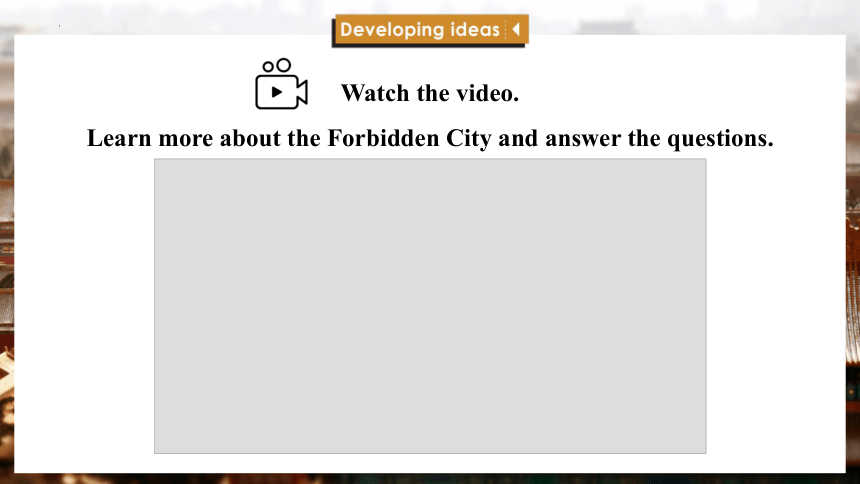
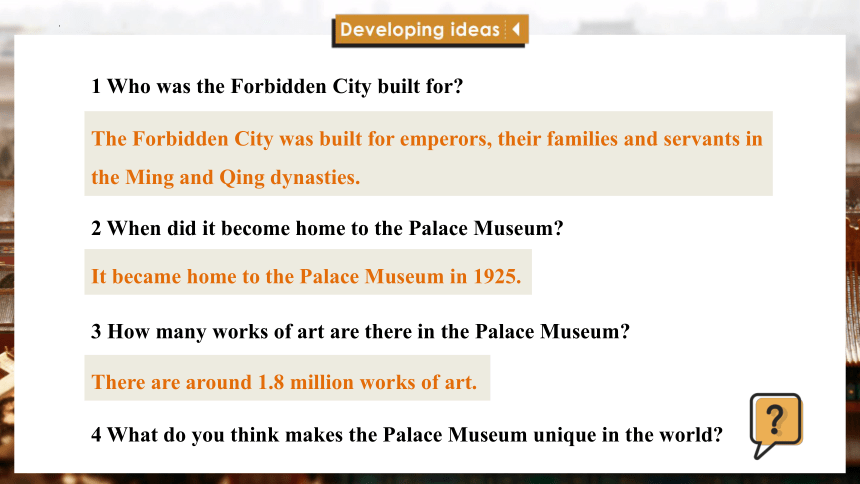
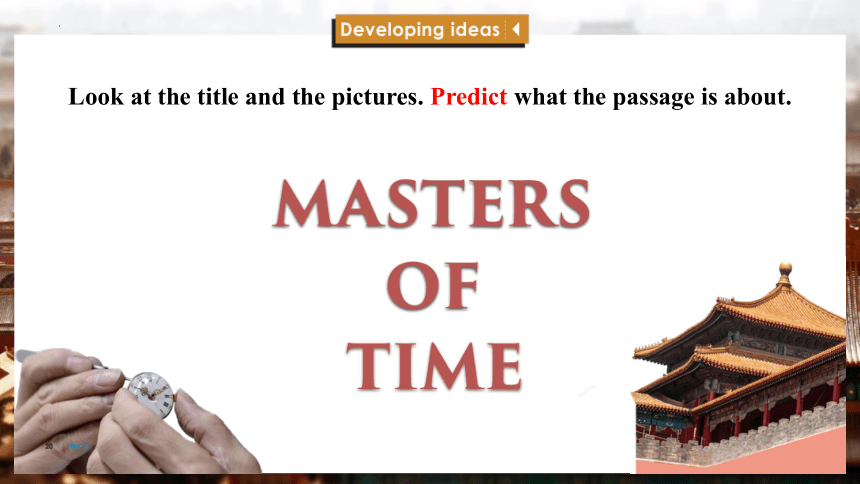
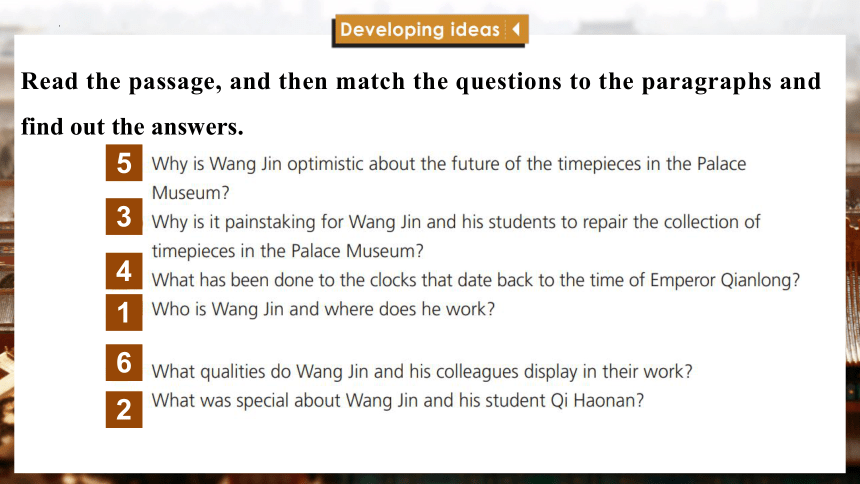

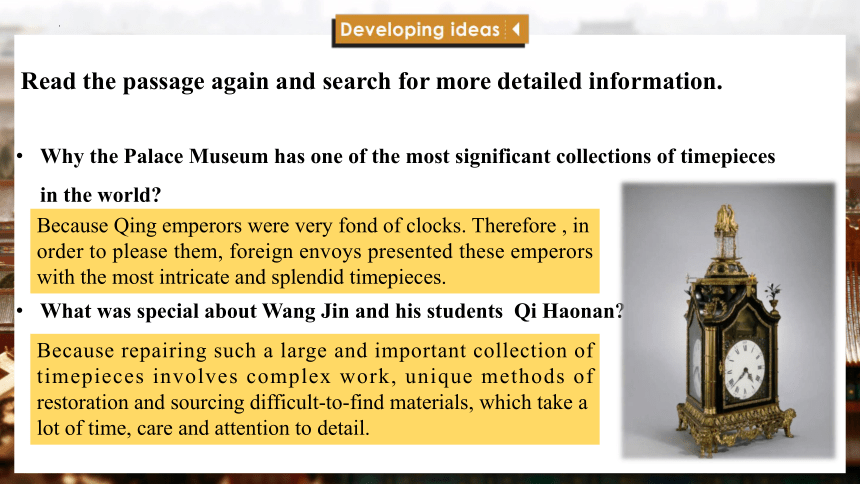
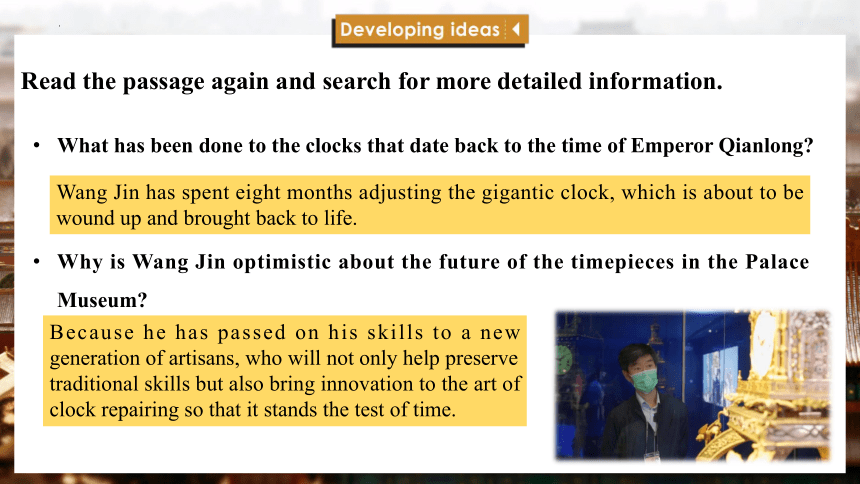
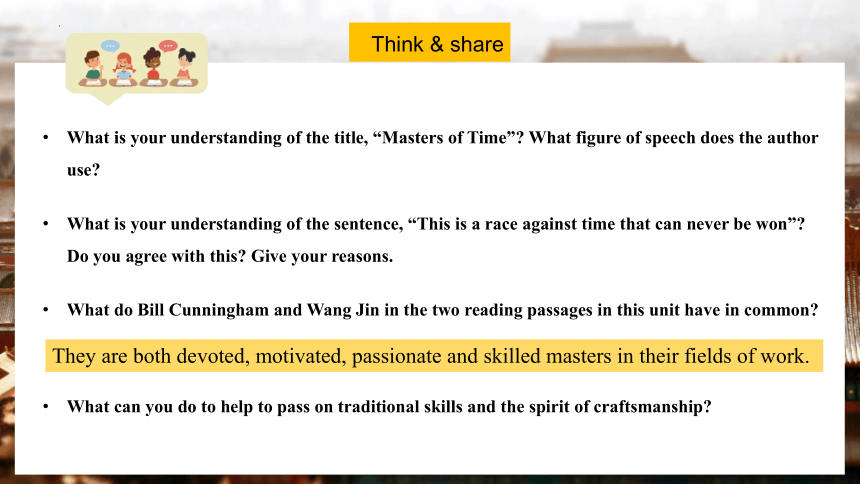
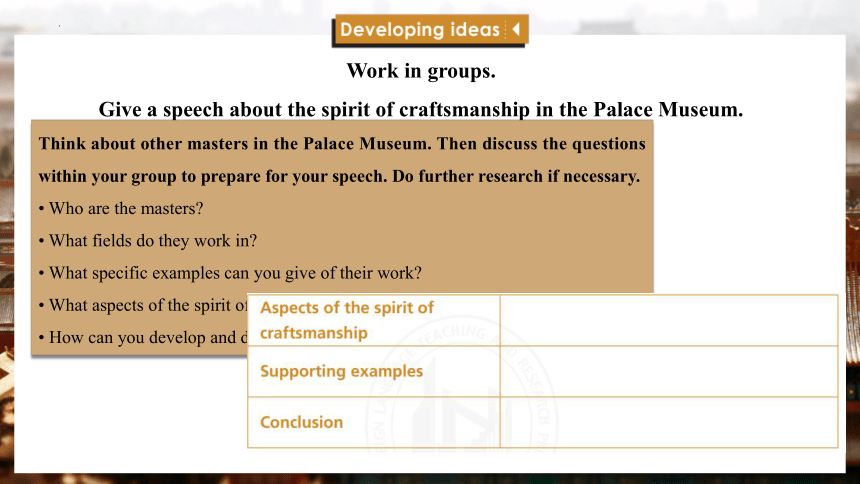

文档简介
(共30张PPT)
Unit 2
A life’s work
Where is this
Have you ever been to the Forbidden City
What do you know about it
Watch the video.
Learn more about the Forbidden City and answer the questions.
1 Who was the Forbidden City built for
2 When did it become home to the Palace Museum
3 How many works of art are there in the Palace Museum
4 What do you think makes the Palace Museum unique in the world
The Forbidden City was built for emperors, their families and servants in the Ming and Qing dynasties.
It became home to the Palace Museum in 1925.
There are around 1.8 million works of art.
Look at the title and the pictures. Predict what the passage is about.
Read the passage, and then match the questions to the paragraphs and find out the answers.
5
3
4
1
6
2
Read the passage again and search for more detailed information.
Who is Wang Jin and where does he work
What was special about Wang Jin and his students Qi Haonan
He is a clock restoration master, working in Xi San Suo in the Forbidden City.
They used to be the only two timepiece restorers in the Palace Museum.
Read the passage again and search for more detailed information.
Why the Palace Museum has one of the most significant collections of timepieces in the world
What was special about Wang Jin and his students Qi Haonan
Because repairing such a large and important collection of timepieces involves complex work, unique methods of restoration and sourcing difficult-to-find materials, which take a lot of time, care and attention to detail.
Because Qing emperors were very fond of clocks. Therefore , in order to please them, foreign envoys presented these emperors with the most intricate and splendid timepieces.
Read the passage again and search for more detailed information.
What has been done to the clocks that date back to the time of Emperor Qianlong
Why is Wang Jin optimistic about the future of the timepieces in the Palace Museum
Because he has passed on his skills to a new generation of artisans, who will not only help preserve traditional skills but also bring innovation to the art of clock repairing so that it stands the test of time.
Wang Jin has spent eight months adjusting the gigantic clock, which is about to be wound up and brought back to life.
Think & share
What is your understanding of the title, “Masters of Time” What figure of speech does the author use
What is your understanding of the sentence, “This is a race against time that can never be won” Do you agree with this Give your reasons.
What do Bill Cunningham and Wang Jin in the two reading passages in this unit have in common
What can you do to help to pass on traditional skills and the spirit of craftsmanship
They are both devoted, motivated, passionate and skilled masters in their fields of work.
Work in groups.
Give a speech about the spirit of craftsmanship in the Palace Museum.
Think about other masters in the Palace Museum. Then discuss the questions within your group to prepare for your speech. Do further research if necessary.
Who are the masters
What fields do they work in
What specific examples can you give of their work
What aspects of the spirit of craftsmanship are demonstrated through their work
How can you develop and display such spirit in daily life
Give your speech to the class.
Now think about your performance in the speech.
Vote for the most convincing speech and ask the speaker to share some public speaking skills.
1. preserve
preserve...from (doing)....
preserve the peace
preserve food
a wildlife preserve=a wildlife reserve
练习:这种药是用来保健而不是治病的。
The medicine is to ________ health rather than treat illness.
preserve
保护......免受......
维护和平
保存食物
野生动植物保护区
Vocabulary
2. comprise
be comprised of
consist of
be composed of
be made up of
练习:我们的饮食中大约有 15%的蛋白质
Around 15% of our diet _______________ protein.
is composed of
包括;包含;由……组成(或构成)
由……组成
构成,组成;由……组成
由……组成/构成
Vocabulary
3. maximum
a maximum of
at (the) maximum
to (the) maximum
minimum
at a minimum
reduce/keep sth to a minimum
练习:这至少要3个月。
This would take three months ________________.
at a minimum
最多
最多;最大程度上
到极限
n. 最小值;最少量
至少;最小
将某物降到/保持在最低限度
Vocabulary
4. associate
be associated with
associate…with…
associate with sb.
association
in association with
练习:
People often associate Weifang _____ kites.
with
与……有关/有联系
把……与……联系起来
与某人交往,与某人混在一起
n. 联系;关联;社团,协会
与……有关联;与……联合
Vocabulary
5. at one's own pace
at a...pace
gather pace
keep pace with
set the pace
pace up and down
练习:
Students study ______ their own pace and the teachers seldom set tests.
at
以……速度
加快步伐
与……并驾齐驱, 与……步调一致
领先,起带头作用
踱来踱去
Vocabulary
6. day in, day out
week in, week out=week after week
month after month
year after year
year by year
little by little
step by step
练习:
___________________ (日复一日地), no matter what the weather is like, she walks ten miles.
Day in, day out/Day after day
连续几个星期,一周又一周
一月又一月
年年,年复一年
一年一年地,逐年
一点一点地,逐渐地
逐步地
Vocabulary
Where is this
What do you know about these places
the Summer Palace
Yuanmingyuan
Chengde Mountain Resort
Read the passage (P. 23) and answer the questions.
Writing an expository essay
What is the passage about
What qualities of the Lei family are mentioned Find examples in the passage to support your answers.
What is the conclusion of the passage
The passage is about the Lei family, who for seven gernerations were behind the marvels of imperial architecture.
The qualities mentioned are those of skill, innovation diligence and humility. This is evident in their buildings surviving for hundreds of years, in their use of a pioneering grid system to plan their projects, in each generation’s conscientious learning of their craft and undertaking ambitious projects, and in their works being more associate with the imperial court than with them.
Although the names of those who created these remarkable works may not be known by future generations, their spirit of craftsmanship is everlasting.
Choose one person who demonstrates the spirit of craftsmanship and complete the notes.
Do further research if necessary.
Writing an expository essay
expository
说明的,解释的
in light of
鉴于;按照,根据
Now write an expository essay!
Work in pairs.
Make improvements to each other’s essays and share them with the class.
Consider how well you have understood how to write expository essays
Writing an expository essay
Introduction
The vividly coloured, finely shaped figurines of "Clay Figure Zhang have been seeing a surge in popularity as an authentic and valuable traditional craft.
Sample
Main body
The nearly 200-year history of “Clay Figure Zhang” began with Zhang Mingshan, who became known for his ability to breathe life and beauty into these painted clay figurines. Born into a poor family, Zhang Mingshan made them as a means of earning a living. He often visited markets where he observed people of all walks of life, and went to theatres to observe those performing on stage. Day in, day out, he used tonnes of clay to mould what he saw and sometimes added decorative items or new features to the figurines. So vivid and lifelike were they that they attracted crowds of spectators to the stand from which he sold them.
Sample
Conclusion
Fortunately, Zhang Mingshan’s craftsmanship has been passed down through his descendents, with these distinctive clay figurines now being crafted by the sixth generation of “Clay Figure Zhang”.
Sample
Read the two points of view and answer the questions.
Activity 1
1 What is James trying to express
2 What is Ivy trying to express
3 Which person do you agree with
Work in groups and take sides.
Think of arguments to support your point of view and make notes.
Activity 2 & 3
Prepare for a debate. Consider the following
1 the roles and responsibilities for each member of your group
2 your arguments, opening and summary
3 the opposing arguments you might face and how you can respond to them
4 useful words, expressions and structures
Share your ideas with the class!
Activity 2
Homework
Review the vocabulary learned in this class.
Improve and revise your composition.
See you next class!
Unit 2
A life’s work
Where is this
Have you ever been to the Forbidden City
What do you know about it
Watch the video.
Learn more about the Forbidden City and answer the questions.
1 Who was the Forbidden City built for
2 When did it become home to the Palace Museum
3 How many works of art are there in the Palace Museum
4 What do you think makes the Palace Museum unique in the world
The Forbidden City was built for emperors, their families and servants in the Ming and Qing dynasties.
It became home to the Palace Museum in 1925.
There are around 1.8 million works of art.
Look at the title and the pictures. Predict what the passage is about.
Read the passage, and then match the questions to the paragraphs and find out the answers.
5
3
4
1
6
2
Read the passage again and search for more detailed information.
Who is Wang Jin and where does he work
What was special about Wang Jin and his students Qi Haonan
He is a clock restoration master, working in Xi San Suo in the Forbidden City.
They used to be the only two timepiece restorers in the Palace Museum.
Read the passage again and search for more detailed information.
Why the Palace Museum has one of the most significant collections of timepieces in the world
What was special about Wang Jin and his students Qi Haonan
Because repairing such a large and important collection of timepieces involves complex work, unique methods of restoration and sourcing difficult-to-find materials, which take a lot of time, care and attention to detail.
Because Qing emperors were very fond of clocks. Therefore , in order to please them, foreign envoys presented these emperors with the most intricate and splendid timepieces.
Read the passage again and search for more detailed information.
What has been done to the clocks that date back to the time of Emperor Qianlong
Why is Wang Jin optimistic about the future of the timepieces in the Palace Museum
Because he has passed on his skills to a new generation of artisans, who will not only help preserve traditional skills but also bring innovation to the art of clock repairing so that it stands the test of time.
Wang Jin has spent eight months adjusting the gigantic clock, which is about to be wound up and brought back to life.
Think & share
What is your understanding of the title, “Masters of Time” What figure of speech does the author use
What is your understanding of the sentence, “This is a race against time that can never be won” Do you agree with this Give your reasons.
What do Bill Cunningham and Wang Jin in the two reading passages in this unit have in common
What can you do to help to pass on traditional skills and the spirit of craftsmanship
They are both devoted, motivated, passionate and skilled masters in their fields of work.
Work in groups.
Give a speech about the spirit of craftsmanship in the Palace Museum.
Think about other masters in the Palace Museum. Then discuss the questions within your group to prepare for your speech. Do further research if necessary.
Who are the masters
What fields do they work in
What specific examples can you give of their work
What aspects of the spirit of craftsmanship are demonstrated through their work
How can you develop and display such spirit in daily life
Give your speech to the class.
Now think about your performance in the speech.
Vote for the most convincing speech and ask the speaker to share some public speaking skills.
1. preserve
preserve...from (doing)....
preserve the peace
preserve food
a wildlife preserve=a wildlife reserve
练习:这种药是用来保健而不是治病的。
The medicine is to ________ health rather than treat illness.
preserve
保护......免受......
维护和平
保存食物
野生动植物保护区
Vocabulary
2. comprise
be comprised of
consist of
be composed of
be made up of
练习:我们的饮食中大约有 15%的蛋白质
Around 15% of our diet _______________ protein.
is composed of
包括;包含;由……组成(或构成)
由……组成
构成,组成;由……组成
由……组成/构成
Vocabulary
3. maximum
a maximum of
at (the) maximum
to (the) maximum
minimum
at a minimum
reduce/keep sth to a minimum
练习:这至少要3个月。
This would take three months ________________.
at a minimum
最多
最多;最大程度上
到极限
n. 最小值;最少量
至少;最小
将某物降到/保持在最低限度
Vocabulary
4. associate
be associated with
associate…with…
associate with sb.
association
in association with
练习:
People often associate Weifang _____ kites.
with
与……有关/有联系
把……与……联系起来
与某人交往,与某人混在一起
n. 联系;关联;社团,协会
与……有关联;与……联合
Vocabulary
5. at one's own pace
at a...pace
gather pace
keep pace with
set the pace
pace up and down
练习:
Students study ______ their own pace and the teachers seldom set tests.
at
以……速度
加快步伐
与……并驾齐驱, 与……步调一致
领先,起带头作用
踱来踱去
Vocabulary
6. day in, day out
week in, week out=week after week
month after month
year after year
year by year
little by little
step by step
练习:
___________________ (日复一日地), no matter what the weather is like, she walks ten miles.
Day in, day out/Day after day
连续几个星期,一周又一周
一月又一月
年年,年复一年
一年一年地,逐年
一点一点地,逐渐地
逐步地
Vocabulary
Where is this
What do you know about these places
the Summer Palace
Yuanmingyuan
Chengde Mountain Resort
Read the passage (P. 23) and answer the questions.
Writing an expository essay
What is the passage about
What qualities of the Lei family are mentioned Find examples in the passage to support your answers.
What is the conclusion of the passage
The passage is about the Lei family, who for seven gernerations were behind the marvels of imperial architecture.
The qualities mentioned are those of skill, innovation diligence and humility. This is evident in their buildings surviving for hundreds of years, in their use of a pioneering grid system to plan their projects, in each generation’s conscientious learning of their craft and undertaking ambitious projects, and in their works being more associate with the imperial court than with them.
Although the names of those who created these remarkable works may not be known by future generations, their spirit of craftsmanship is everlasting.
Choose one person who demonstrates the spirit of craftsmanship and complete the notes.
Do further research if necessary.
Writing an expository essay
expository
说明的,解释的
in light of
鉴于;按照,根据
Now write an expository essay!
Work in pairs.
Make improvements to each other’s essays and share them with the class.
Consider how well you have understood how to write expository essays
Writing an expository essay
Introduction
The vividly coloured, finely shaped figurines of "Clay Figure Zhang have been seeing a surge in popularity as an authentic and valuable traditional craft.
Sample
Main body
The nearly 200-year history of “Clay Figure Zhang” began with Zhang Mingshan, who became known for his ability to breathe life and beauty into these painted clay figurines. Born into a poor family, Zhang Mingshan made them as a means of earning a living. He often visited markets where he observed people of all walks of life, and went to theatres to observe those performing on stage. Day in, day out, he used tonnes of clay to mould what he saw and sometimes added decorative items or new features to the figurines. So vivid and lifelike were they that they attracted crowds of spectators to the stand from which he sold them.
Sample
Conclusion
Fortunately, Zhang Mingshan’s craftsmanship has been passed down through his descendents, with these distinctive clay figurines now being crafted by the sixth generation of “Clay Figure Zhang”.
Sample
Read the two points of view and answer the questions.
Activity 1
1 What is James trying to express
2 What is Ivy trying to express
3 Which person do you agree with
Work in groups and take sides.
Think of arguments to support your point of view and make notes.
Activity 2 & 3
Prepare for a debate. Consider the following
1 the roles and responsibilities for each member of your group
2 your arguments, opening and summary
3 the opposing arguments you might face and how you can respond to them
4 useful words, expressions and structures
Share your ideas with the class!
Activity 2
Homework
Review the vocabulary learned in this class.
Improve and revise your composition.
See you next class!
